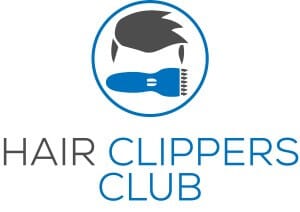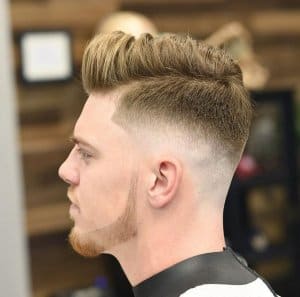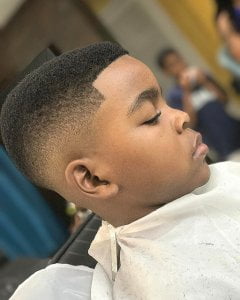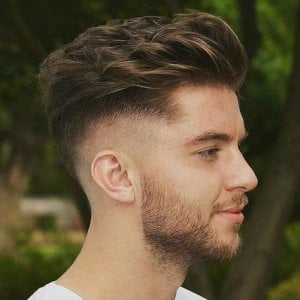Taper fades are probably more popular than ever these days.
There are so many different types of fades that there really is a fade haircut for just about any type of hair out there.
Whether you are White, Black, Asian or Hispanic, you have a number of choices for the best fade for your hair type.
Low fades, medium fades, high fades, whatever one you think suits you best, you just need to find a good barber who specializes in fades.
In this article I will go through the different types of fades and who they are best for.
First, let’s talk about what is a fade, exactly.
What is a Fade Haircut?
A fade is simply a taper haircut and the two terms are kind of used interchangeably. We’ll get into the difference between a fade and taper in a minute.
To put it simply, a fade starts out very tight at the bottom of the head and gradually gets longer the higher up the head you go.
If you do a skin fade, for instance, then the bottom edges are bald and slowly it gets longer. The top can be short too, but longer than skin, obviously.
This effect is what gives this kind of taper its name as it looks like the hair is fading into the skin.
By blending the different lengths as it gets longer, your barber can make it look very natural without any shadows, or lines showing so it looks like the hair just grows out that way.
The taper fade is nothing new. It has been in use in the military for decades or longer. And in Hispanic and African American culture, it has been a hairstyle for a very long time.
Only recently has the taper fade become mainstream enough that you even see guys rocking it in an office setting.
What is the Difference Between a Fade and a Taper
As I mentioned, all fades are tapers. A taper is anything that starts narrow and goes wide.
Think of the tapered legs of a table. Or a tapered candle.
Remember tapered jeans in the 80’s?
So, when talking about fade vs taper, we are basically talking about the same thing.
Here is the difference, though.
A taper is not always a fade. Any regular haircut, even a simple trim, will likely be a taper as it is shorter at the bottom and gradually gets longer as you progress up the head. So a taper haircut can look nothing like a taper fade and vice versa.
Confused yet?
Don’t be.
These days many guys ask for fades with a specific clipper guard number and then how high they want the fade. You’ll still get a regular haircut even if you ask for a number 3 guard fade.
But, if you are looking for a fade where it gets very tight around the sideburns or neckline, you probably already know what type of fade you want or can at least describe it to your barber who will know how to get it done.
What are the Different Types of Fade Haircuts?
For the sake of brevity, I will go into the main ones that if you ask for you will get what you are looking for in a fade.
The problem is that there are so many variations on each of the types of fades that I could be here for days going through them all. And that also wouldn’t even include the different ways to ask for the same thing depending on where in the country you are!
Let’s get into the list to see which is the best fade for you!
High Fade Haircut
A high fade is similar in a way to a high and tight in that there isn’t much of a taper towards the bottom. It starts out longer on top, then right below the crown it is already showing skin.
Since there is less real estate to work with between where the skin is showing and the longer hair on top, high fade haircuts will have more shadow and less of a gradual fade.
The practical advantage of getting a high fade is that you can buy yourself a little more time between haircuts as by the time it grows in, it is still pretty short.
Don’t confuse the high fade with an undercut as there is no taper with an undercut. A true undercut is the same level from the bottom to the top and is disconnected. There are undercut fades, and yes, those would also be high fades, but asking for an undercut fade won’t get you a classic high fade.
A high fade still blends the sides into the top, albeit with a more dramatic blend in.
This can work as a crew cut, buzz cut, comb-over or pompadour, among other hairstyles. The point is that it doesn’t actually matter how long or short your hair on top is.
| Types of high fade | Also called |
|---|---|
|
|
|
|
| |
|
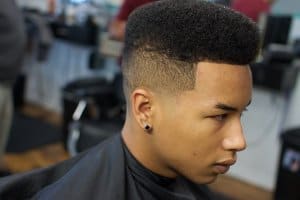
Image Courtesy of Flickr user Teodoro Mino
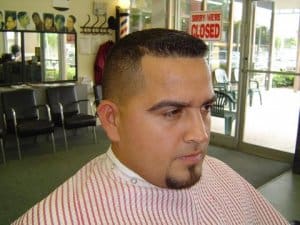
Image Courtesy of Flickr user Teodoro Mino
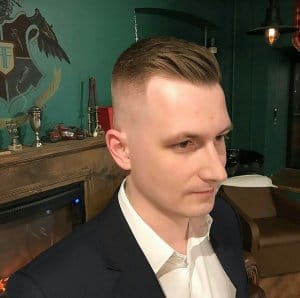
Image Courtesy of Flickr user Teodoro Mino
Low Fade Haircut
A low taper fade is very tight at the bottom and the blend in starts right away. It can still be tight and close as you get towards the crown, but it is really only bald at the bottom.
A low fade is the more conservative between the high fade vs low fade.
In many office settings these days it is acceptable to have a low fade where skin is only showing towards the neckline and over the ears.
In some cases the low fade is just a faded over the temples and at the neckline. In those cases, it can be a dramatic change between skin and then quickly thicker hair where there is no skin showing any higher than the ear line.
This type of fade works best with longer hair on top. Think, quiff, pompadour, comb over or even spiky hair.
This definitely works best with longer hair in general. If you have the top buzzed you may want to consider a high or mid fade haircut.
| Types of low fades | Also called |
|---|---|
|
|
|
|
| |
|
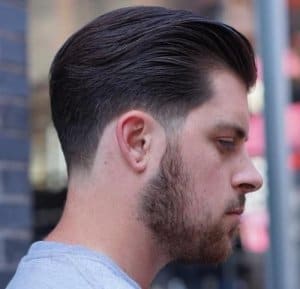
Low Fade/Blow Out Courtesy of Flickr user Fashion Passion
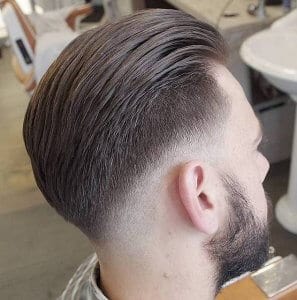
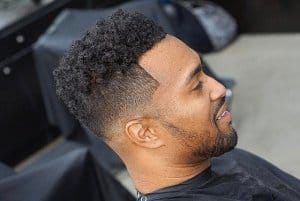
Low Fade Image Courtesy Flickr user Budthebarber
Mid Fade Haircut
As the name suggests, the spot where the main shadow of the taper begins is about midway up the head. Generally, around the same level as the eyes.
If it is a skin mid fade, then it literally is down to the skin around the middle of the head and then quickly blends into the hair on the crown of the head.
The mid bald fade can work with many different styles on the top of the head, depending on how short a fade it is.
A skin mid bald fade will likely work better with either something short on top or a quiff, or comb over. If your barber is really on point then you can get away with a longer style on top like a big pompadour or a long fringe. Just keep in mind that any kind of bald fade, the blend in gets decidedly more difficult to do with the longer hair on top.
But, since there is some room to work with vs a high fade, you can get away with skin or bald fades. Even a drop fade could work with a mid fade.
| Types of mid fades | Also called |
|---|---|
|
|
|
|
| |
|
How to Ask Your Barber for a Fade Haircut
After working as a barber for the last 10 years, the biggest challenge is interpreting what a customer is actually asking for.
I have gotten good at reading between the lines and understanding what he is asking for even when he isn’t being very clear.
To make sure you get exactly the type of fade haircut you are looking for, let me give you some tips on how to tell the barber what you want.
Clipper Guard Numbers
Many guys would ask for a certain number fade, like a number 1 for example and expect it to be like a formula that you just ask for a certain number to describe the haircut.
The number for a fade is just what number blade you want us to start with. So a number 1 fade will start with that blade at the bottom and then gradually get longer either by using different blades, or in the case of an adjustable blade clipper by gradually opening up the blade.
Here is a list of clipper blade sizes to help you understand the lengths.
The clipper blade only tells us half the story, though.
Do you want a number 1 blade as a low fade, mid fade or high fade? You have to let us know where you want the blend in to begin.
Know how you want it on top
Since it is very difficult to go from skin to very long on top, you may want to think about the style on top before you decide on the type of fade.
If the barber knows that you want a messy look on top, or you want a comb over with a hard razor part, or maybe you want a crew cut. Then that will probably determine how high the blend in should start.
Have an idea of if you want a low, medium or high fade, but be flexible if you’re asking for something the barber doesn’t think is going to look right or is even out of his level of expertise.
Start out longer
With any type of haircut, fade or otherwise, always remember the golden rule at the barber.
We can take hair off, but we can’t put it back on.
With that in mind, it is wise if you are getting a fade for the first time to go longer to start. If you think it looks good as it is, you’re all set. Write it down and ask for it next time.
If you think it should be shorter at the bottom, or maybe you want to bring the fade up higher, then let the barber know.
It’s better to go conservative first.
Thinking of doing a skin fade for the first time?
Start with a number 1 low fade and see how it looks. You may be shocked by how much skin is visible with that length and call it a day.
Want a high fade?
Start out with a longer clipper blade up high so you can see if it will look right and will properly blend in. If you think it could be closer to the skin where the fade begins then this is the time to go for it.
Bring a picture, but be realistic
It is always helpful to bring a picture of the type of fade and haircut you are looking for. Sometimes words fail and looking at a picture will tell the barber all he needs to know to get it right without any guesswork.
Here’s the thing about bringing pictures, though.
You can’t look like Forest Whitaker and expect to come out looking like Will Smith.
Seriously.
It isn’t even just about your looks. Different hair types, hair growth patterns, etc. all play a part in every haircut. So, the fade haircut in the picture may not even be possible because of your hair anyway.
If the barber says it isn’t going to work, then maybe take a chance going somewhere else, or face the facts that you have to be adaptable.
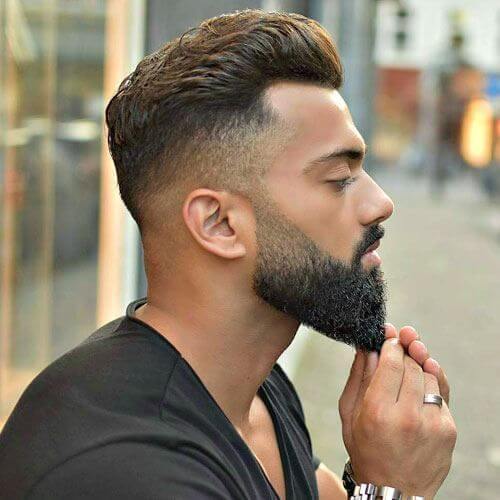
How to Get a Fade Haircut with Beard
When you are getting a taper fade, you also need to make sure you let the barber know you want a beard fade with it.
Few haircuts with beards look worse than a fade where the beard length just kind of stops where the fade starts.
You need to basically have a reverse fade where the skin goes into the beard from the top down.
In most cases, you’re going to be asking for a low fade on the beard, so it really is just a quick blend in from the end of where the sideburn would be into the beard.
Now, you can really have fun with a beard fade and basically do the same thing as you would for a fade haircut.
You could go from skin on the temple and fade right down into a sort of Van Gogh pointed beard.
You could do a mid beard fade and keep stubble from the temple down into about the middle of the cheek area.
Really, you are only limited by your imagination and your beard type.
One thing to really keep in mind is that for a beard fade to really work, you also need to ask your barber for a good beard trim, too.
I’m an outdoor enthusiast and have sported a full beard since I was in my early 20’s. Originally, growing a beard was a way to save time when getting ready each day, but I quickly realized that keeping a neatly trimmed beard takes work and some forethought. That’s where this site comes in.
You get to benefit from my years of experience. I’ve reviewed many of the top hair clippers on the market today and also included some information on what works best for me. A great beard will turn lots of heads in your direction.
Since I never know when I’m going to find myself being photographed, whether it’s climbing in Yosemite, or playing volleyball on the beach, it’s important to me to always look my very best. Maintaining my beard is part of my daily routine and I hope you’ll find some useful tips and information on this site to help you on your journey.
